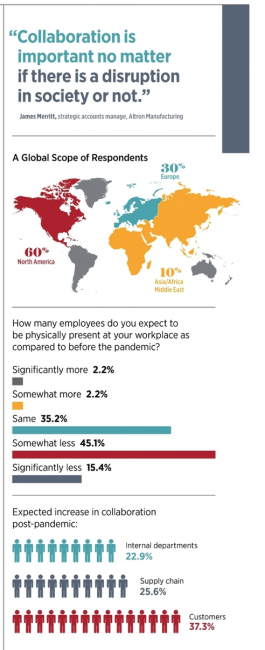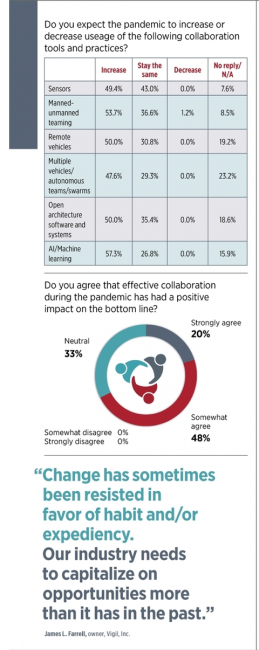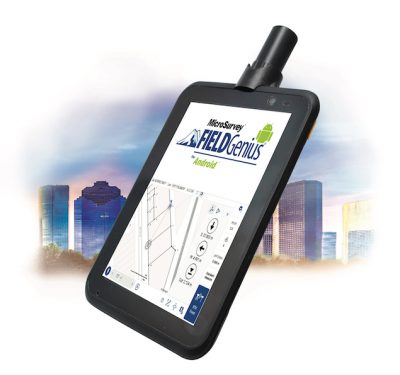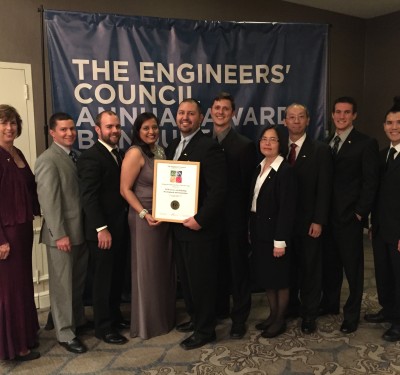
During May, as the first rays of beyond-COVID sunshine could be detected, Inside Unmanned Systems asked our e-newsletter and social media communities, and also attendees at AUVSI’s XPonential virtual event, to describe their key post-pandemic expectations.
We solicited opinions about how effective collaboration during COVID-time has and can change practices within and across autonomous companies, along the supply chain, with customers, and between manned and unmanned systems. We also asked about effective collaboration’s influence on the bottom line.
Of course, factors from technology to regulation to talent will also shape the collective autonomous future. “Post-pandemic, it’s a culture shift,” said Preeta Raman, who is a product marketing leader at Boeing. “There’s more acceptance—or resignation—that things are now more virtual, more automated, more intelligent.”
But this difficult period has shown that effective, smart collaboration can support success going forward. “Collaboration is not gated anymore by physical presence,” Raman added. “It’s a new way of doing things for people.”
THE RESPONDENTS
Vehicle, sensor, camera and mapping manufacturers; end users; government, academia and miscellaneous employees answered the survey questions. The scope was global: 60% were headquartered in North America, nearly 30% in Europe and the remainder worked within Africa, the Middle East and Asia. About a third of employers were single-location companies, but one-quarter of firms had more than 10 sites—interestingly, size did not greatly affect overall responses.

OFFICE, REMOTE, EVENTS
Just 5% of respondents were from companies that had worked completely remote pre-pandemic. But 18% of the others had not returned to a physical workplace as of publication. Expectations were divided over whether any return would happen by June 30th, September 30th or (plurality) the end of 2021—one person predicted 2022.
Once back, though, 60% of respondents expected somewhat or significantly fewer employees to be physically present compared to before the pandemic.
“The pandemic has proven once and for all that our organization can operate effectively with 90% of employees working from home,” said a manager for a major sensor company.
Correspondingly, virtual meetings seem here to stay. Six in 10 respondents expected more virtual meetings post-pandemic, specifically for technology, operations and building teams.
“Video meetings are much more flexible and ‘viable’ in a world where teams cooperate across different locations,” said Brig. Amul Asthana (ret.), vice president projects at the 200-person training simulator company Zen Technologies, of Hyderabad, India. Perhaps exacerbated by India’s current precarious COVID situation, Asthana cited the “’drag down’ which would be imposed by travel.” But he saw a permanent shift: “I find I can work simultaneously on many projects, which would have been less feasible but for video conferencing.”
As for in-person events, nearly 40% expected to attend fewer of them than they did before the pandemic, compared to 8% who thought they would attend more.
SURGING COLLABORATION
“Collaboration is important no matter if there is a disruption in society or not,” said James Merritt, strategic accounts manager of Altron Manufacturing, a 1,000-plus-employee electronic contract manufacturer based in Anoka, Minnesota.
While a majority of survey respondents thought the frequency of various types of collaboration would remain the same, significant numbers predicted increases within and beyond their walls. One of those who did was Will Conway, a GIS electric system technician with a large electric utility in Florida. “The compartmentalizing or pigeonholing of employees reduces the effectiveness of change,” Conway said. For Zen Technology’s Asthana, cooperation is an antidote. “Collaboration requires the participants to ‘adapt’ in terms of outreach, procedures, outlook.”
• CUSTOMERS: Nearly 40% of respondents expected to increase customer collaboration; just 6% predicted a decrease.
• SUPPLY CHAIN: A quarter of all respondents expected increased supply chain collaboration; just 2% thought it would decrease.
• INTERNALLY: Eight percent felt internal-departmental collaboration would decrease post-COVID, but 23% expected inter-departmental collaboration to increase.
Greg Beck, a California-based business development manager for 1,000-plus-employee German electronics manufacturing service provider Zollner Electronics, hoped customer collaboration would increase post-pandemic. “I think during COVID there has been less communication with customers, mostly the minimum needed. So from a sales perspective, I am not gaining trust like I used to with face-face meetings, traveling, trade shows, etc. With these now slowly coming back toward ‘normal,’ I see increased engagement with customers, increased trust and therefore more opportunities in the next 12 months vs. 2020/COVID.”
The sensor-company manager was all in. “We are actively driving cross-functional collaboration across our organization and embedding it in our processes.”

COLLABORATION PRACTICES
Respondents were asked specifically whether six types of human and human-machine collaboration practices would increase or decrease post-pandemic. Again, these ranged from AI to open architecture software and systems.
Not one respondent expected a decrease in the use of sensors, remote vehicles, multiple vehicles/autonomous teams/swarms, open architecture software and systems, and AI/machine learning, and just 1% foresaw a decrease in manned/unmanned team use.
By more than two to one, respondents predicted an increase for AI/machine learning—this likely reflects a pandemic-independent shift toward data-driven technology. Similarly, a 15% shading toward increased post-pandemic open architecture use may suggest how “frenemies” need to collaborate to handle massive data sets and scenarios, or to fulfill challenge-laded government contracts. The only category held to a single-digit increase in expected usage was sensors; this 5% differential likely reflects that technology already being an industry staple. “As automation increases, so does the need for sensors,” Altron’s Merritt noted. “It’s a safety thing.”
That said, there are collaboration cautions.
“With fewer people involved with development the process can increase in speed,” Conway, the GIS system technician, said. But the gleaning and completeness of usable and directly imputable data for all downstream customers is paramount, he added. “That requires systemwide collaboration. The support of facility maintenance, network connectivity, network meter reading for billing, asset management, load analysis and disaster recovery, not to mention tertiary users, has to be built into the front end.”
Also, some may seek to disrupt integration and collaboration. “For systems, it’s going to be ever-increasing machine to machine collaboration, but also a greater challenge with securing those interactions,” Raman said. “Increased machine to machine or sensor to sensor communications are coming, but present new attack surfaces that malicious actors or hackers can exploit to cause unpredictable financial losses/outcomes.”
COLLABORATION AND BUSINESS
Would effective collaboration during the pandemic have a positive impact on the bottom line? Would it increase revenue?
• THE BOTTOM LINE? More than two thirds of respondents somewhat or strongly agreed that effective collaboration during the pandemic has had a positive impact on the bottom line.
• REVENUE INCREASE? Respondents were more divided on whether collaboration during COVID time increased revenue. One-quarter thought not, but fully 40% strongly or somewhat supported a positive bottom-line impact.
UNEXPECTED COLLABORATIONS
Effective collaboration may come from surprising situations.
James L. Farrell is a sole proprietor, of Severna Park, Maryland, consulting support firm Vigil, Inc. Yet he’s found ample opportunity to collaborate with others. “Change has sometimes been resisted in favor of habit and/or expediency,” he said. “Our industry needs to capitalize on opportunities more than it has in the past.
“The best collaborations are synergistic,” Farrell continued. “For me, that has meant joining forces, first with Ohio University professors who arranged flight tests validating my algorithms [for satellite navigation and air traffic management], subsequently with others to expand advocacy via SAE, then again with SAE for new interface standards to unleash capability improvement by requiring availability of raw measurement data.”
And Altron’s James Merritt believes collaboration needs to be instilled way before employment—with elementary school students. “This gets the introverts and extroverts working together for the common goal of creation at a young age and creates a better understanding of team work. Training the young is our greatest opportunity to be successful in space.”
Zen Technologies’ Asthana summed it all up: “Collaboration is the way forward, so let us adapt.”






